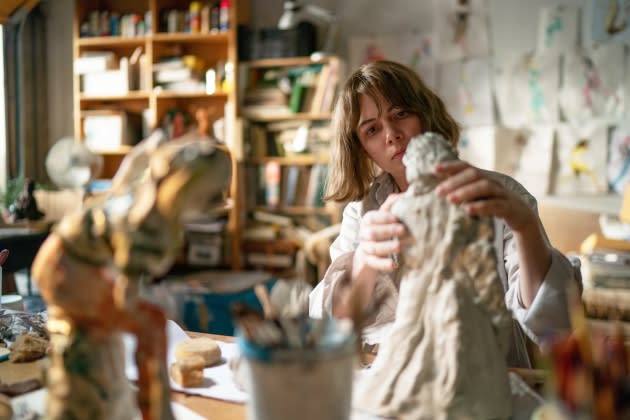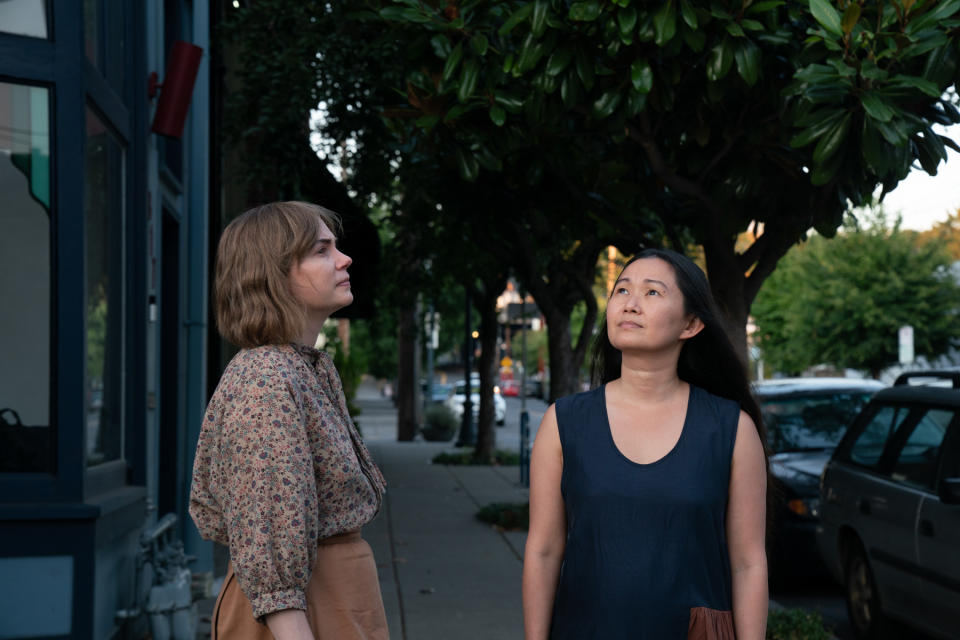‘Showing Up’ Is an Early Contender for Best Movie of the Year
- Oops!Something went wrong.Please try again later.

Art can be taken in (or, from a more mercenary point of view, consumed) as something abstract, enlightening, subtextual, subversive, thought-provoking, transcendental. The actual making of it, however, depends on a very specific inspiration-to-perspiration ratio. Showing Up is all about putting the work into artwork, what it takes to marshal the blood, sweat, and tears to produce something personally expressive and profoundly moving. Or even something pretentious and self-involved and elitist to a fault — those sculptures and paintings and, yes, motion pictures can’t all be masterpieces. Anything creative requires labor, whether the end result soars into the stratosphere or falls flat on its face, and that’s the part this portrait of an artist wants you to recognize. The finger of divinity touching your forehead may grant you an idea. It’s the callouses on your hands that make it a reality.
That this moody, woozy character study falls closer to the “masterpiece” side of the fence isn’t a surprise, considering it comes from Kelly Reichardt and Michelle Williams, one of the best filmmaker-actor duos of the last quarter century. The Portland-based director specializes in emotionally messy people, work-perpetually-in-progress types, women on the verge. Her collaborator-cum-muse not only cues into that wavelength beautifully but can humanize those flawed females without sanding or watering them down. These two are an ideal match, whether they’re telling stories of fringe dwellers (Wendy & Lucy), alienated suburbanites (Certain Women) or settlers in the wild, weird West (Meek’s Cutoff). They know exactly how to harmonize around the Pacific Northwest’s disharmonious.
More from Rolling Stone
A24 Turns Portland Into Michelle Williams' Own Art Studio in 'Showing Up' Trailer
'The Fabelmans': Steven Spielberg Turns the Camera on His Deepest, Scariest Subject: His Childhood
Lizzy, the sculptor shuffling her way through Showing Up’s storyline, is one of the more dissonant characters they’ve conjured. A consistently displeased presence in Crocs and socks, she spends most of her time in a garage studio that could be a centerfold spread for Boho Cluttered Chic magazine. Lizzy has a show coming up in a week or so, and she’s having a hard time getting things finished. To be fair, there are a lot of obstacles standing between her and her deadline. Like Lizzy’s landlord Jo (Hong Chau), who also has a gallery opening coming up. She hasn’t been able to fix the broken water heater, and no hot water means no showers. But don’t worry, Jo’s on it. And check out the cool tire swing she just made! (You may identify with this neo-hippie or be as irritated with her as Lizzy is, but Chau’s brilliant interpretation of certain funky, flighty, slightly self-involved artistic types should be studied in acting and writing classes regardless.)
There’s also a hungry cat yowling at her, and a wounded pigeon she’s talked into birdsitting, and a day job at an art school. Plus some family issues, notably the fact that her brother (John Magaro) has stopped taking his meds and is starting to spiral into dangerous, paranoid-delusions territory. For a movie about hard work, Reichardt’s po-faced Portland art-world farce pays a lot of attention to how hard it is to get any real work done. Lizzy may have a lot of things stacked in her favor: her mom is her boss, she gets free use of the school’s kiln run by a laid-back teacher (André Benjamin), and as Jo reminds her, the rent’s cheap. But that doesn’t mean she has time or energy to devote to truly following her bliss. Not even a sculptor in a hipster utopia, one shot by cinematographer Christopher Blauvelt as if every day was like Sunday, can get their work-life balance in check.

Cowritten by Reichardt’s partner-in-scribe Jonathan Raymond, Showing Up is designed to be an off-kilter showcase for Williams, who leans in to Lizzy’s short-fused temper, passive-aggressive tendencies, and dark-cloud outlook on life. She never acts like a victim, but the actor lets you see glimpses of a persecution complex simmering right below the surface: Why can’t people just let her do her job?! There are also hints of doubt layered right above a genuine need for nurturing something, whether it’s that broken-winged pigeon (she eventually bonds with it) or her mentally unstable brother. Lizzy can be cantankerous. She’s never less than complicated, however. And the more you watch Williams externally molding and sculpting those small, unformed clay figures in a handful of long takes, the more you feel her doing the same thing to Lizzy’s interior life, with just as much delicacy and attention to detail.
It’s also a bit of a dryly comic screwball served up at eephus-pitch speed, slyly milking snickers at Lizzy’s slow-burn impatience with Jo, her parents, her peers and, well, virtually everything and everyone else. There’s a discourse around cheese etiquette at gallery openings. Some side business involving Matt Malloy and Amanda Plummer as two visitors mooching off of Lizzy’s dad, played by Judd Hirsch as a blithely oblivious art-world alpha male, never gets drawn out because it doesn’t need to be. When things do get heavy, Reichardt has a way of pulling back before they become maudlin or leaden. She also rigs up a climactic set piece that you think is going to turn into a social car wreck before pirouetting into an absolutely stunning moment of grace. Even the final crane shot seems buoyant.
Showing Up doesn’t want to make the making of art look easy. It wants you to see the strain of a creative life, the toll such dedication takes, the willingness to sacrifice in the name of saying “I did this” even when fame, fortune or an audience you can count on two hands seems like a pipe dream. The irony isn’t that it takes two incredible, hard-working artists and their fellow performers, crew members, etc. to lay that out for you. It’s that they’ve embedded that idea within the story of a struggling sculptor who’s her own worst enemy and made it seem like the most deceptively casual and naturally wonderful work of art in ages.
Best of Rolling Stone

